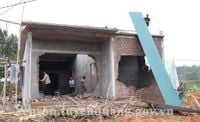On May 9, 2025, Prime Minister Pham Minh Chinh chaired a significant Government meeting focused on the reorganization of administrative units across all levels in Vietnam. This meeting addressed the crucial project of merging administrative units at the provincial level, eliminating the district level, and establishing a new model for local government organization consisting of two levels.
The Ministry of Home Affairs has recently submitted a proposal to the Government regarding the arrangement of administrative units at the commune level in Ho Chi Minh City for 2025. According to this proposal, Ho Chi Minh City will see a substantial transformation, with its total area expanding to over 6,772 km² and a population exceeding 14 million people. Following the reorganization, the city will consist of 168 administrative units at the commune level, which includes 113 wards, 54 communes, and the Con Dao special zone.
Among the notable changes, Hiep Binh ward will be established from the merger of Hiep Binh Chanh, Hiep Binh Phuoc, and part of Linh Dong ward. This newly formed ward is projected to have a population of over 215,000 people within an area of 16.01 km². The headquarters for the Hiep Binh ward will be located at 2 Street 5, the former site of the Hiep Binh Chanh Ward People's Committee.
Similarly, Tang Nhon Phu ward will be created by merging several existing wards, including Hiep Phu, Tan Phu, Tang Nhon Phu A, Tang Nhon Phu B, and part of Long Thanh My. This ward will cover an area of 16.51 km² and will accommodate more than 208,000 residents, with its government headquarters situated at 29 Le Van Viet, previously the headquarters of Tang Nhon Phu A ward.
Additionally, Ba Diem commune will be formed from the merger of Xuân Thới Thượng, Trung Chánh, and Ba Diem communes from Hoc Mon district. These changes are part of a broader initiative to streamline governance and improve service delivery to citizens.
During the mid-April session of the Ho Chi Minh City People's Council, a thematic meeting was convened to discuss and approve critical aspects of the administrative restructuring, including the merging of wards and communes and the endorsement of significant investment projects. The council agreed on the policy to merge Ba Ria - Vung Tau, Binh Duong, and Ho Chi Minh City, collectively known as Ho Chi Minh City, which will serve as the administrative and political center.
In this context, the Ho Chi Minh City People's Council also endorsed the plan to reorganize administrative units at the commune level, reducing the number from 273 units to 102, which represents a decrease of 62.3%. This includes 62 units with populations under 100,000, 23 units with populations between 100,000 and 150,000, and 17 units with populations ranging from 150,000 to 200,000.
Prime Minister Chinh emphasized that the reorganization is not merely an administrative task but a historical necessity aimed at enhancing the efficiency of governance. In his remarks, he stated, "This is a very important issue, of a historical nature, not only arranging the organization, apparatus, and cadres, but also promoting decentralization of authority; allocating resources; creating new development space, especially building a government in the direction of being close to the people, better serving the People, and changing from a passive state to proactively serving the people and businesses."
The implementation of these plans is expected to ensure the uninterrupted operation of government agencies while maintaining the daily activities of citizens and businesses. The Government has established a Steering Committee to oversee the arrangement of administrative units and the construction of the two-level local government organization model.
Localities across Vietnam have been urged to implement the directives from the Central Government and the Politburo diligently. This includes gathering public opinions and preparing personnel work as part of the administrative restructuring process. The meeting on May 9 was critical for the Government to review the progress on the arrangement of administrative units and the establishment of the two-level local government organization.
Following this meeting, agencies will continue to expedite the completion of necessary documents and procedures to submit to the National Assembly Standing Committee and the National Assembly for further consideration and approval.
As Vietnam moves forward with this ambitious restructuring plan, the focus remains on creating a government that is more responsive and closer to the people. The changes are seen as a step towards a more efficient administrative framework that will better serve the needs of citizens and foster economic growth.





